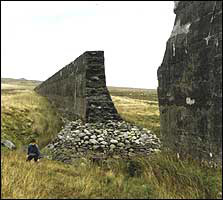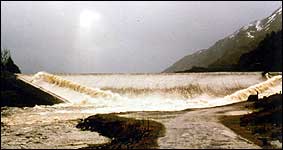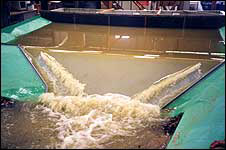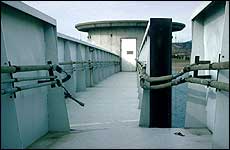Dam Safety
The Dolgarrog Disaster, 1925

The failed section of the Eigiau Dam
In 1925, the failure of two dams caused a flood that swamped the village of Dolgarrog in North Wales, killing 16 people. The disaster was started by the failure of the Eigiau Dam, a small gravity dam. The water released from the reservoir flooded downstream, and overtopped the Coedty Dam, an embankment dam. This dam failed, releasing the huge volume of water that flooded Dolgarrog.
Reservoir Safety Legislation
The disaster at Dolgarrog led the British parliament to pass the Reservoirs (Safety Provisions) Act in 1930 that introduced laws on the safety of reservoirs. This has since been updated, the current legislation is:
- in England and Wales: the Reservoirs Act 1975,
- in Scotland: the Reservoirs (Scotland) Act 2011,
- in Northern Ireland: the Reservoirs Act (Northern Ireland) 2015
These Acts cover the safety of all reservoirs in the United Kingdom that can hold at least 10,000 or 25,000 cubic metres of water, depending on location (currently the 10,000 cubic metre lower limit only applies in Wales). Under the Acts, there are "Panels" (or groups) of civil engineers who are responsible for checking the safety of these reservoirs and their dams. They are called "Panel Engineers", and they can only belong to the Panels if they are considered to be well qualified, and experienced, in reservoir safety matters. Every reservoir has to be inspected every 10 years, or more often, when it is necessary. Panel Engineers also get involved with the construction of new reservoirs and repairs and changes to existing ones.
The Acts make reservoir owners, operators and managers legally responsible for the safety of their reservoirs. They are required to employ suitably qualified civil engineers to make regular checks on safety in between the Panel Engineers' inspections.
Checking Dam Safety
Severn Trent Water have kindly provided an example training manual (Raw Water Reservoir Surveillance Training Manual), which provides awareness in regard to the management of reservoirs, the importance of undertaking regular surveillance and monitoring tasks, different types of reservoirs, how they are constructed, likely reasons for failure and the legislation covering reservoirs.
These are some of the safety checks that engineers do:
Visual inspection
A visual inspection of a dam, and its surrounding area, are an important part of a reservoir safety check. Unusual features on the face of a dam may reveal important clues about the condition of its internal body.
At embankment dams, the civil engineer looks for cracks, bulges and hollows on the downstream face and on the upstream face, when the water is low. These features could indicate that the dam is becoming unstable, and that there is a possibility that, with time, a portion of the slope could collapse, just like a landslide. Hollows can also indicate that floodwater has been overtopping the dam and gradually eroding the downstream slope. Engineers also look for signs of water leakage through or underneath the dam. Water leaking through the dam can erode away the material inside gradually creating a large cavity. Eventually, the cavity can collapse in on itself reducing the stability of the dam. Water leaking under the dam can indicate that there is a problem in its foundation.

Inspection gallery running
through a dam
Concrete dams have tunnels running through them called inspection galleries. These are just big enough for a person to walk through, so the engineer can inspect the condition of the dam inside as well as outside. The surface of the concrete is checked for deterioration and cracking. The engineer also looks for any signs that could show that the dam or sections of it are moving. Checks are also made for any leaks.
On all types of dams the condition of water pipes, valves and floodgates are checked. The valves and gates are operated regularly to check that they will work when required.
Monitor behaviour
Although dams look solid, they do move under the forces of nature, and water seeps through tiny pores (or spaces) in their structure. The weight of an embankment dam actually causes its own height to reduce over a number years. This is called settlement. A reservoir pushes a dam over a little and tries to make it slide on its foundation. Dams contract and expand as their temperature changes throughout the year. Civil engineers ensure the stability of dams by designing them to minimise water seepage and the effects of natural forces.

Changes in the behaviour of a dam occur slowly, so dams are monitored regularly using scientific instruments that can measure very small changes. This way any undesirable behaviour can be detected well before it causes a major problem. Some instruments are permanently installed in dams, while others are taken to the site to make measurements.
These are some the things that are monitored.
Seepage and leakage
Leakage or increased seepage can indicate that there is a crack in a dam. In embankment dams, it could indicate that internal erosion of the fill material is taking place.
Settlement
Levels on the crest of an embankment dam are measured, using optical instruments, to check whether there has been a reduction in the dam's height. Settlement of the crest can be a warning of problem occurring within the body of the dam. The crest level is designed to be a certain height above the normal full reservoir level. This ensures that the dam is not overtopped by excess floodwater or by waves on windy days.
Tilting
Pendulums are installed in vertical shafts in concrete dams to measure how much the dam is tilting over.
Horizontal Movements
A dam can move horizontally, in either the downstream or upstream direction. This movement can be measured on the crest using optical or computer-based equipment. Excessive movements can indicate that the dam is sliding and becoming unstable.
Floods
A dam is designed to hold back water that flows into the valley behind it, and to control the amount of water that passes through it. Hydrologists estimate the quantity of water that will flow into a reservoir. Civil engineers use this information to choose the location and height of the dam. The dam has to be high enough to ensure that it will not be overtopped by excess flood water, unless it is designed to do so.
Floodwater passing over the spillway of Treig dam near Fort William in Scotland
Accidental overtopping could damage property downstream. Worse, it could wash away part of the downstream side of an embankment dam, affecting its stability, and causing it to collapse. Then, a catastrophic flood could occur as the water is released from the reservoir, causing death and destruction where the people live downstream.

A scale model of the spillway for Trieg Dam
Floodwater is usually passed through a reservoir using a spillway. Where people and property are at risk, it is important that spillways can safely pass the largest flood imaginable. Hydrologists estimate the size of this flood by studying past rainfall records for the area and considering recent climate changes. They use the information to design new spillways and to check existing ones. Often, small-scale models are used to check the design.
Earthquakes
Every year, between 200 and 300 earthquakes are detected in Britain. The majority of them are very small, but about every eight years at least a Magnitude 5 earthquake occurs. It is thought that a Magnitude 6 earthquake is about the biggest that could ever occur in Britain, but the chance of that happening is very small. A Magnitude 6 earthquake can damage structures that are poorly constructed or that have not been designed to resist earthquakes.
The consequences of a dam failing during an earthquake are very serious, because the water released from the reservoir could cause severe flooding downstream. For this reason, new and existing dams in Britain are checked for the effects of earthquakes.
There are a few dams in Britain which are believed to have been affected by earthquakes. The most significant case was in 1957 when Blackbrook Dam, in Leicestershire, was affected by a Magnitude 5.3 earthquake. The tremors caused heavy coping stones to shift and cracks appeared in the faces of this gravity dam constructed from concrete and masonry.

Damaged bridge to outlet tower

Los Angeles Dam
These pictures show the Los Angeles Dam and outlet tower, in California, in the United States. During the Magnitude 6.8 Northridge earthquake of 1994, the bridge to the tower was damaged when the central section was dislodged from its supports and thrown sideways.
Find out more about earthquakes in Britain from the British Geological Survey